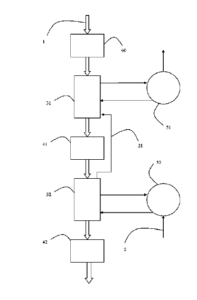Editor’s Note: Positive environmental and commercial considerations have driven the rapid rise of secondary aluminum in achieving about a third of global aluminum consumption today. Data from the Aluminum Association and the International Aluminum Institute indicate that recycling aluminum uses 90-95% less energy compared with primary aluminum and ~75% of all aluminum ever produced since the industry began is constantly being used today. This sustainable secondary aluminum industry structure has grown with the needs of aluminum user industries to incorporate changing patterns of aluminum product use and the rise of global “green industry initiatives” established by the United Nation Industrial Development Organization (www.unido.org). Terms such as scrap and waste are high on their agenda.
Some 60-70% of total recycled aluminum is used in the production of foundry alloys, which have high maximum iron and trace element levels in their alloy specifications. These are mainly used by the automotive industry for die castings. Recycling wrought aluminum alloys used in sheet and extrusion applications is more challenging, as meeting their more stringent chemical specifications requires special remelting and ingot casting procedures, as well as modified downstream production practices. However, recycling more costly wrought aluminum alloys pays dividends. The selected patents below aim to optimize the numerous aluminum recycling and recovery technologies by creating unique pretreatment and refining operations required in attaining quality secondary aluminum products that user industries, such as transport, packaging, and others demand.
— Joseph C. Benedyk, Editor
US11649119 — RAW MATERIAL SUPPLY DEVICE, DEVICE FOR PROCESSING ELECTRONIC AND ELECTRICAL DEVICE PART SCRAPS, AND METHOD FOR PROCESSING ELECTRONIC AND ELECTRICAL DEVICE PART SCRAPS — JX Nippon Mining & Metals Corporation (Japan) — A raw material supply device and a device for processing electronic and electrical device part scraps, which can control dropping positions of a raw material containing substances having different shapes and specific gravities, and a method for processing electronic and electrical device part scraps using those devices. The raw material supply device includes a receiving port, a discharge port, a first guide surface, and a second guide surface on a surface opposing to the first guide surface. The processing device includes a first conveying unit, a raw material supply device, a second conveying unit, and a pyramid-shaped disperser. The processing method comprises a sorting step, wherein the sorting step comprises dropping the electronic and electrical device part scraps onto a plurality of dispersion surfaces of a pyramid-shaped disperser and dispersing the electronic and electrical device part scraps in a plurality of directions on a conveying surface.
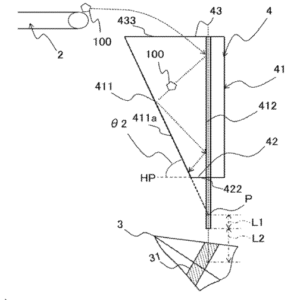
US11635258 — EXHAUST HOOD OVERFLOW SYSTEM — GPRE IP, LLC (USA) — An overflow system for a doorway exhaust hood on an aluminum metal melt furnace having an eductor gas circulator that collects excess VOC’s that escape from the gate or doorway. The system includes a manifold with an inlet near the hood’s lower lip, and a conduit between the manifold and eductor. A blower draws gas into the manifold and urges that gas through the conduit, into the eductor, and into the furnace. Sensors detect when the door is open and the volatiles level under the hood. An electronic controller instructs the blower to draw exhaust gases through the manifold when the door is open and the volatiles level exceeds a predetermined level.
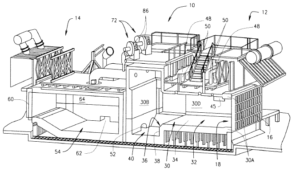
US11624102 — METHOD AND DEVICE FOR PRODUCING FEEDSTOCK IN PIECE FORM FROM METAL — Norsk Hydro ASA — The disclosure relates to a method for producing feedstock in piece form from metal, in particular aluminum and/or aluminum alloys, for a metal-casting installation, in particular aluminum-casting installation, in which scrap parts of metal, in particular of aluminum and/or aluminum alloys, are sorted on the basis of their alloying constituents and/or alloy contents and subsequently, on the basis of an alloy to be produced in the feedstock, the scrap parts are mixed into a composition having a homogeneous distribution of the alloy and fed to a press, in which the scrap parts of the composition are subjected to a pressure that compresses the scrap parts while generating a temperature, wherein, as a result of the application of pressure, the scrap parts are heated up to the transition temperature between solid and liquid of at least some of the scrap parts and/or the alloys and/or alloying constituents thereof before the feedstock is discharged in a specific geometrical form.
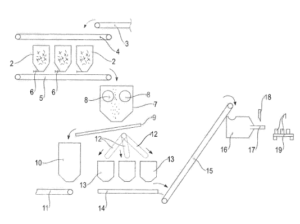
US11619448 — SCRAP SUBMERGENCE DEVICE — Pyrotek, Inc. (USA) — The production, processing, and recycling of metals, such as aluminum, commonly requires melting metal stock, such as scrap stock, that has a high surface area to weight ratio (also referred to as light gauge stock), including scalper chips generated from milling rolling ingots, turnings or swarf from lathe or sawing operations, and output from crushers or shredders used to recycle aluminum sheet, extrusions, or cast shapes. A molten metal scrap submergence system comprising a furnace and a vortexing scrap submergence well. The vortexing scrap submergence well includes a diverter suspended above the well and oriented for immersion in a bath of molten metal circulating within the well. The system, or an alternative scrap submergence system, can include a hood element disposed in an overlapping position with regard to a top opening of the scrap submergence well. The hood at least substantially seals the top opening. The hood element includes a scrap piece feed chute and a burner allowing carbon containing vapor evaporated from the surface of the molten scrap pieces to combust and form predominantly water. The system, or an alternative scrap submergence system can include internal side walls of the well with a first diameter portion adjacent and above said ramp and a second, larger diameter portion above said first portion.
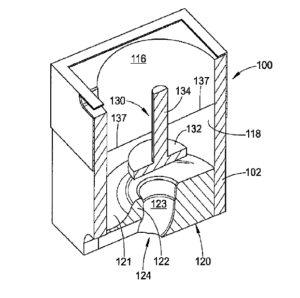
US11591574 — ALUMINUM ALLOY SHEET — UACJ Corporation and Toyota Jidosha Kabushiki Kaisha (Japan) — An aluminum-alloy sheet has a chemical composition containing Si: 2.3-3.8 mass %, Mn: 0.35-1.05 mass %, Mg: 0.35-0.65 mass %, Fe: 0.01-0.45 mass %, and at least one element selected from the group consisting of Cu: 0.0010-1.0 mass %, Cr: 0.0010-0.10 mass %, Zn: 0.0010-0.50 mass %, and Ti: 0.0050-0.20 mass %. The ratio of the Si content to the Mn content is 2.5 or more and 9.0 or less. The aluminum-alloy sheet exhibits an elongation of 23% or more and a strain hardening exponent of 0.28 or more at a nominal strain of 3%. Such an aluminum-alloy sheet is well suited for press forming (stamping) applications, such as forming automobile body panels. By setting the Si content, the Mn content, the Fe content, etc. of the chemical composition of the aluminum-alloy sheet within the above-mentioned specific ranges, advantageous aluminum-alloys sheets can be manufactured from casting materials (raw materials) containing a high percentage of aluminum scrap, even if the entire source of aluminum in the casting material is aluminum scrap. For this reason, the materials cost of such above-mentioned aluminum-alloy sheets can be reduced without difficulty.
US11577288 — SHREDDER DUST PROCESSING METHOD AND PROCESSING DEVICE FOR SAME — Envitech Engineering Co., Ltd. (Japan) — A shredder dust treatment method is provided wherein non-metal dust which is further pulverized into a small particle size in a pulverizing step S10 through a crushing step S1 of crushing wastes such as waste automobiles, waste home appliances, and waste office furniture into a predetermined size, an iron component separation and collection step S3 of separating and collecting an iron component, a non-ferrous component separation and collection step S4 of separating and collecting a non-ferrous component, a metal component separation and collection step S5 of sorting a metal component, wind power sorting steps S2, S6, S8, and S9 of sorting floating fibrous dust and a settled crushed material by wind power, and a shredding step S7 of shredding the settled crushed material into a predetermined size is separated into metal scraps such as copper, aluminum, and iron, fibrous dust, and particulate dust in a separating step S11.
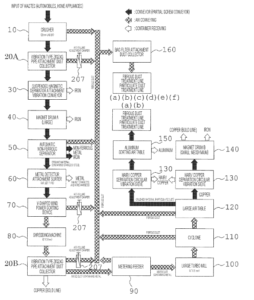
US11548729 — RECYCLING SYSTEM WITH DISCRETE CONVEYOR BINS FOR IMPROVED ACCURACY — Oregon Beverage Recycling Cooperative (USA) — Recycling systems can include a conveyor system, an optical device, and a processor operable to detect, identify, and count redeemable objects. The conveyor system can include a plurality of bins and be configured to move the bins from a first end of the conveyor system to a second end of the conveyor system. The optical device can be situated and configured to capture an image of a plurality of objects within a bin of the conveyor system. A processor including computer-readable instructions can be configured to detect and identify the objects within an image captured by the optical device as belonging to one or more object classes. Each object class can determine whether an object is redeemable or unredeemable. The processor can be configured to provide a count of only those objects identified as redeemable.
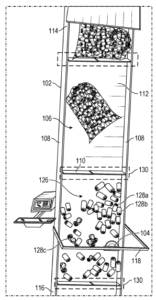
US11543357 — METAL SORTING SYSTEM USING LASER INDUCED BREAKDOWN SPECTROSCOPY AND OPERATING METHOD THEREOF — Gwangju Institute of Science and Technology (Korea) — Disclosed is an operating method of a metal sorting system using laser induced breakdown spectroscopy (LIBS), which may include: analyzing a metal component distribution for various metals using LIBS library information; setting multiple clusters according to the metal component distribution; performing first regression component analysis with respect to spectral data of a metal sample; calculating a probability that the spectral data will belong to each of the set multiple clusters using the first regress component analysis result; performing second regression component analysis with respect to the spectral data which belong to each cluster; and discriminating a type of metal sample by a weighted sum of the calculated probability and the second regression component analysis result.
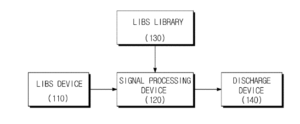
US11541426 — SORTING APPARATUS WITH A LIBS LASER DEVICE — Binder + Co. AG (Austria) — Sorting apparatus including a chute, on which objects are moved in succession by gravitational force, the chute having a cutout with a measuring region. The LIBS (Laser Induced Breakdown Spectroscopy) method is used in particular in connection with the sorting of metals and ores, in order to obtain a rapid analysis of the metals or ores present. A LIBS laser device is arranged adjacent to the cutout to carry out spectroscopic measurement on the moving objects. A separating device separates out certain objects, and a control device controls and/or adjusts the separating device as a function of the measurement results of the LIBS laser device. The chute includes at least a first portion, through which the objects can be moved first and centered normal to the conveying direction by gravitational force, and a second portion that is flat. The cutout includes the measuring region is arranged in the second portion.
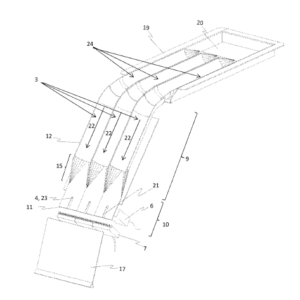
US11538302 — SYSTEM AND METHOD OF SELLING GOODS OR SERVICES, OR COLLECTING RECYCLE REFUSE USING MECHANIZED MOBILE MERCHANTRY — The Coca-Cola Company (USA) — The present invention relates to a system and method of selling goods or services, or collecting recycle refuse using mechanized mobile merchantry, comprising positioning, by self-propelling, at least one of a mechanized mobile merchantry within a geographical boundary, allowing interaction with consumers, and effectuating selling of goods or services, or collection of recycle refuse with consumers. Other exemplary embodiments can include signaling a mechanized mobile merchantry with a consumer’s mobile device to direct the merchantry to self-propel to the consumer’s location and utilizing usage logs and algorithms to optimize functionality of a fleet of merchantry and reposition the merchantry, as necessary, within a geographical boundary, to increase sales and consumer convenience. The present invention also relates to a waste collection system with an option to deliver new food and beverage items includes a customer service robot comprising a slave computer and one or more waste receptacles to collect waste material. The customer service robot includes at least one robotic arm having at least three degrees of motion to facilitate collection from, e.g., tables and the like. The customer service robot is also capable of interfacing with a recycling unit and a master computer to control disposal of the collected waste.
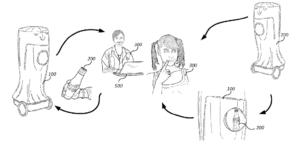
US11519599 — OPPOSED-INJECTION ALUMINUM MELTING FURNACE UNIFORM COMBUSTION SYSTEM — Guangdong University of Technology (China) — The invention discloses an opposed-injection aluminum melting furnace uniform combustion system which comprises: a furnace body, a first heat storage unit, a second heat storage unit, and four fuel injection guns disposed diagonally on two end walls of the furnace body comprising a first fuel injection gun located on the first end wall of the furnace body adjacent to the second heat storage unit, a second fuel injection gun located on the second end wall of the furnace body adjacent to the first heat storage unit, a third fuel injection gun on the second end wall of the furnace body adjacent to the second heat storage unit, and a fourth fuel injection gun located on the first end wall of the furnace body adjacent to the first heat storage unit, the gas injection direction of the first fuel injection gun is parallel with that of the second fuel injection gun with a spacing H between the axes thereof, the gas injection direction of the third fuel injection gun is parallel with that of the fourth fuel injection gun, with a spacing H between the axes thereof, and the spacing H between the axes is set to a quarter to one tenth of the furnace body width, such that the gas entering the chamber are oppositely-injected to form a swirling flow.
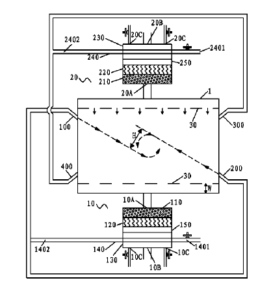
US11519057 — ALUMINUM ALLOY FOR IMPACT EXTRUDED CONTAINERS AND METHOD OF MAKING THE SAME — Ball Corporation (USA) — Novel aluminum alloys are provided for use in an impact extrusion manufacturing process to create shaped containers and other articles of manufacture. Accordingly, the present invention contemplates a novel system, device, and methods for using scrap aluminum materials including aluminum alloy 3XXX series, such as 3104, 3004, 3003, 3013, 3103 and 3105 in combination with other metal materials to create a unique and novel aluminum alloy. In one embodiment blends of recycled scrap aluminum are used in conjunction with relatively pure aluminum to create novel compositions which may be formed and shaped in an environmentally friendly process. Other embodiments include methods for manufacturing a slug material comprising mixtures of aluminum alloys for use in the impact extraction process, a container manufactured using the aluminum alloy in an impact extrusion process, and the container, wherein the material of the container is the aluminum alloy.
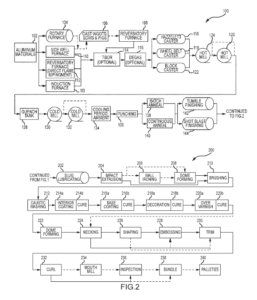
US11486642 — MULTI-CHAMBER MELTING FURNACE AND METHOD FOR MELTING NON-FERROUS SCRAP METAL — Gautschi Engineering GMBH (Switzerland) — A multi-chamber melting furnace for melting scrap of non-ferrous metals, in particular aluminum scrap, including a first shaft furnace with a shaft for charge material, in which impurities of the charge material can be removed, and at least one furnace chamber which is connected to the shaft of the first shaft furnace and has a first heat supply device, wherein at least one second shaft furnace with a shaft for charge material, in which shaft impurities of the charge material can be removed, the furnace chamber being connected to the shaft of the second shaft furnace and being arranged between the shafts in such a manner that the furnace chamber forms a main melting chamber in which the molten bath is located during operation.
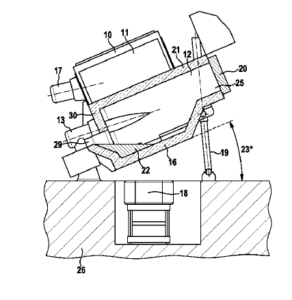
US11465858 — ACTUATED AIR CONVEYOR DEVICE FOR MATERIAL SORTING AND OTHER APPLICATIONS — AMP Robotics Corporation (USA) — Actuating an air conveyor device is disclosed, including: causing an airflow to be generated by an airflow generator of an air conveyor device, wherein the airflow generator is configured to cause the airflow to enter an intake port of the air conveyor device and exit from an outlet port of the air conveyor device in response to receiving air at an air input port of the air conveyor device; causing a target object to be captured by the air conveyor device using the airflow; activating a positioning actuator mechanism to position the air conveyor device; and causing the target object to be ejected from the air conveyor device. For example, the random and unsorted contents of a collection truck may be unloaded at the facility onto a conveyor belt where airflow motivated material sorting takes place.
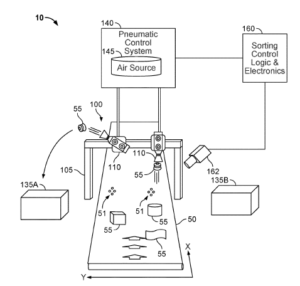
US11441844 — METHOD OF RECYCLING HEAT — Omachron Intellectual Property Inc. (Canada) — This disclosure provides a method of recycling heat during operation of a plant in which equipment for processing at least two different materials are co-located. The method comprises a first process for processing a first material and a second process for processing a second material. The second material has a melting point that is less than the melting point of the first material. During the first process, the first material is subjected to a first melting process and then subjected to a first cooling process that includes solidification of the first material. During the second process, the second material is subjected to a second melting process and then subjected to a second cooling process that includes solidification of the second material. The method comprises recovering heat from the first cooling process and using at least some of the heat as a heat source for the second melting process. For example, a different heat stream may be recovered as the steel cools from its melting point downward to, e.g., 800° C. This different heat stream may be used, e.g., to heat and, optionally melt, aluminum, which may have a melting temperature of 660° C.
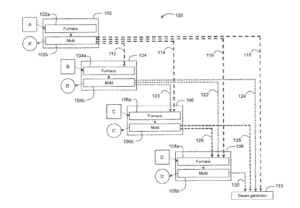
US11441206 — SYSTEM AND METHOD OF OPERATING A BATCH MELTING FURNACE — Air Products and Chemicals, Inc. (USA) — A system and method of controlling a metal melting process in a melting furnace, including determining at least one furnace parameter characterizing a melting furnace, adding a charge containing solid metal into the melting furnace, detecting at least one charge parameter characterizing the charge, firing a burner into the melting furnace to provide heat to melt the charge, and exhausting burner combustion products from the furnace, detecting at least one process parameter characterizing progress of melting the charge, calculating a furnace efficiency based on the at least one furnace parameter, calculating a predicted process pour readiness time based on the at least one charge parameter, the at least one process parameter, and the furnace efficiency, and controlling the metal melting process based on the predicted process pour readiness time.
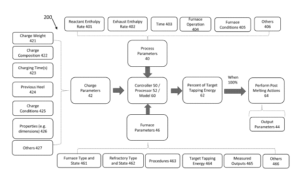
US11420237 — SYSTEM FOR CLEANING METALLIC SCRAPS FROM ORGANIC COMPOUNDS — North American Construction Service Ltd. (USA) — An installation for melting metallic scraps, and particularly adapted for melting aluminum scraps, includes a system for cleaning the metallic scraps and for cleaning the scraps from organic compounds. For this purpose, a first object of the invention is to propose a new system for cleaning metallic scraps, such as aluminum scraps, with an increased control on the parameters for the cleaning without increasing the costs. The system comprises: At least a first chamber provided with an inlet for the scraps and at least a second chamber provided with an outlet for the scraps; a device for controlling the atmosphere in the first chamber and in the second chamber, the oxygen content in the second being above the oxygen content in the first chamber; a temperature controller for heating the first chamber at a temperature adapted to provide pyrolysis of at least a part of the organic compounds and for heating the second chamber at a temperature adapted to provide burning of at least a part of residues of the pyrolysis; and a conveying assembly for conveying scraps from the inlet for scraps in the first chamber toward the outlet for scraps in the second chamber.
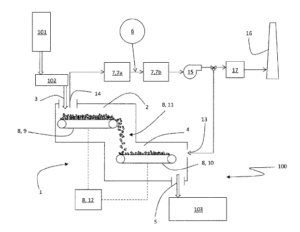
US11358217 — METHOD FOR MELTING SOLID METAL — Molten Metal Equipment Innovations, LLC (USA) — A scrap melting system and method includes a vessel that is configured to retain molten metal and a raised surface about the level of molten metal in the vessel. Solid metal is placed on the raised surface and molten metal from the vessel is moved upward from the vessel and across the raised surface to melt at least some of the solid metal. The molten metal is preferably raised from the vessel to the raised surface by a molten metal pumping device or system. The molten metal moves from the raised surface and into a vessel or launder. One exemplary embodiment of a system for transferring molten metal onto a raised surface comprises at least (1) a vessel for retaining molten metal, (2) a dividing wall (or overflow wall) within the vessel, the dividing wall having a height H1 and dividing the vessel into at least a first chamber and a second chamber, and (3) a molten metal pump in the vessel, preferably in the first chamber. The system may also include other devices and structures such as one or more of a launder, a third chamber, an additional vessel, a rotary degasser, one or more additional pumps, and a pump control system.
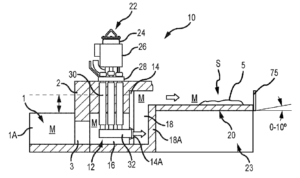
US11358179 — APPARATUS AND METHOD FOR SORTING — AMAG Casting GmbH (Austria) — An apparatus and a method for sorting, particularly chopped, aluminum scrap by alloy groups are disclosed, in which the aluminum scrap is separated into fractions, fractions of the aluminum scrap are irradiated by at least one neutron source, the gamma radiation that the individual fraction emits due to this neutron irradiation is detected by at least one detector, and based on this, an energy spectrum associated with the respective fraction is generated, based on which energy spectrum a relative ratio of the weight proportions of at least two alloy elements of this fraction is determined, and based on this relative ratio, this fraction is allocated to its corresponding alloy group, and then the fractions are sorted by the alloy groups to which they have been allocated.
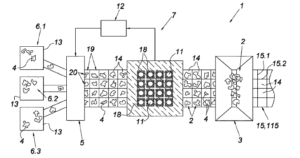
US11311915 — AUTOMATED AERO ALUMINUM SCRAP SORTING SYSTEM BASED ON LASER INDUCED BREAKDOWN (LIBS) TECHNIQUE — The Boeing Company (USA) — A fully automatic online aero aluminum sorting and recovery system based on LIBS (Laser Induced Breakdown Spectroscopy) technology, which belongs to the field of aero aluminum sorting and recovery technology, and is suitable for online sorting, detection and recovery of large batch of aero aluminum. The fully automatic online aero aluminum sorting system based on LIBS technology provided in the present invention consists of six portions: a sample feeding unit (1), a surface treatment unit (2), a material positioning unit (3), a LIBS analysis and detection unit (4), a transfer unit (5) and a sorting and recovery unit (6). The system according to the invention can be used to realize the automatic online detection, sorting and recovery of aero aluminum, and the system does not have requirements on the surface condition of the recovered aero aluminum samples. The sorting accuracy rate is greater than 90% and the sorting rate is not less than 1 block per second.
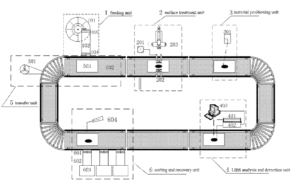
US11278937 — MULTIPLE STAGE SORTING — Sortera Alloys, Inc. (USA) — It is particularly desirable to efficiently separate aluminum scrap metals into alloy families, since mixed aluminum scrap of the same alloy family is worth much more than that of indiscriminately mixed alloys. For example, in the blending methods used to recycle aluminum, any quantity of scrap composed of similar, or the same, alloys and of consistent quality, has more value than scrap consisting of mixed aluminum alloys. Within such aluminum alloys, aluminum will always be the bulk of the material. However, constituents such as copper, magnesium, silicon, iron, chromium, zinc, manganese, and other alloy elements provide a range of properties to alloyed aluminum and provide a means to distinguish one aluminum alloy from the other. A material sorting system separates materials utilizing multiple stages of classification and sorting, including a vision system that implements a machine learning system to identify or classify each of the materials, and Laser Induced Breakdown Spectroscopy (LIBS) to perform a subsequent classification and sorting of the remaining materials.
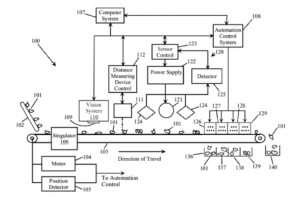
US11203801 — AGE-HARDENABLE AND HIGHLY FORMABLE ALUMINUM ALLOYS AND METHODS OF MAKING THE SAME — Novelis Inc. (USA) — Provided herein are new aluminum alloy products and methods of making these alloys. The aluminum alloy products are age-hardenable, display high strength and formability, and allow for the use of recycled scrap. The aluminum alloys can serve as the core in a clad aluminum alloy product. The products can be used in a variety of applications, including automotive, transportation, and electronics applications. The new aluminum alloys and products possess a combination of high formability, high strength, age-hardenability, and allow for the use of recycled materials in their formation. The aluminum alloys as described herein comprise magnesium (Mg) and silicon (Si), among other optional elements. Thus, in some aspects, the aluminum alloys as described herein can comprising from about 0.5 wt. % to about 1.6 wt. % Mg; from about 0.2 wt. % to about 0.5 wt. % Si; up to about 1.0 wt. % Fe; up to about 0.5 wt. % Cu; up to about 0.5 wt. % Mn; up to about 0.3 wt. % Cr; up to about 0.3 wt. % Ti; up to about 0.5 wt. % Zn; up to about 0.25 wt. % impurities; and Al. In some cases, the weight ratio of Mg to Si in the aluminum alloy can be from about 8:1 to about 1.5:1.
US11193492 — OPEN EXIT MOLTEN METAL GAS INJECTION PUMP — Pyrotek, Inc. (USA) — A molten metal pump comprised of a base defining a pumping chamber, an impeller disposed within said pumping chamber, an outlet passage extending from said pumping chamber, said outlet passage being defined by opposed top and bottom walls and opposed side walls, wherein said top and side walls terminate at an intersection with a boundary of the base and said bottom wall terminates inward from said boundary. According to one particular embodiment, the molten metal pump includes a base defining a pumping chamber and an impeller disposed within the pumping chamber. An outlet passage extends from the pumping chamber. The outlet passage is defined by opposed top and bottom walls and opposed side walls. The top and side walls terminate at an intersection with a boundary of the base and the base wall terminates inward from the boundary. At least one of the top wall and the opposed side walls can include a gas injection inlet. The base wall can terminate at a position outward from perpendicular to the gas injection inlet. Alternatively, the base wall can terminate between the gas injection inlet and the boundary. It is also contemplated that only a center strip of the bottom wall (for example at least 25% and less than 100%) of the overall width of the bottom wall is removed.
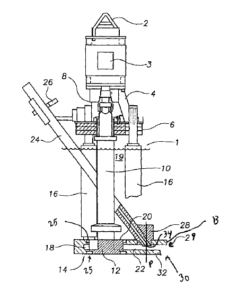
US11192146 — SYSTEM AND METHOD FOR SORTING SCRAP MATERIALS — Huron Valley Steel Corporation (USA) — A system has a conveyor for carrying at least two categories of scrap particles positioned at random on a surface of the conveyor, with at some of the particles comprising metal which are classified and sorted into types of ferrous and non-ferrous metals, heavy metals, high value metals such as copper, nickel or titanium, cast or wrought metals, and other various alloys. The system has a sensor array with a series of analog inductive proximity sensors arranged transversely across the conveyor. An active sensing end face of each sensor lies in a sensing plane, and the sensing plane is generally parallel with the surface of the conveyor. A control system of is configured to sample and quantize analog signals from the series of sensors in the array and locate and classify a scrap particle on the conveyor passing over the array into one of at least two categories of material based on the quantized signals. A method for sorting the particles is also provided.
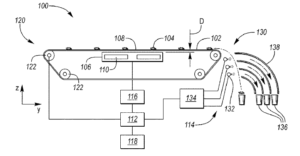
US11180838 — HIGH PERFORMANCE ALUMINUM ALLOYS HAVING HIGH AMOUNTS OF RECYCLED MATERIAL AND METHODS OF MAKING THE SAME — Novelis Inc. (USA) — Provided herein are high performance aluminum alloy products having desirable mechanical properties and methods of making the same. The aluminum alloy products described herein contain a high content of recycled material and are prepared by casting an aluminum alloy to form a cast aluminum alloy product and processing the cast aluminum alloy product. The method of processing the cast aluminum alloy product can include two hot rolling steps. The providing step can comprise melting an aluminum alloy, aluminum scrap, or a combination of these. Optionally, the molten aluminum alloy comprises iron. The iron can be present in an amount of at least about 0.25 wt. % based on the weight of the molten aluminum alloy (e.g., from about 0.25 wt. % to about 0.50 wt. % based on the weight of the molten aluminum alloy). Optionally, the molten aluminum alloy comprises a 2xxx series aluminum alloy, a 5xxx series aluminum alloy, a 6xxx series aluminum alloy, or a 7xxx series aluminum alloy. The iron-containing intermetallic particles can be spherical in shape. In some cases, at least 50% or at least 80% of the iron-containing intermetallic particles present in the product have an area of 0.75 μm2 or less. The aluminum alloy product can be an automobile body part.
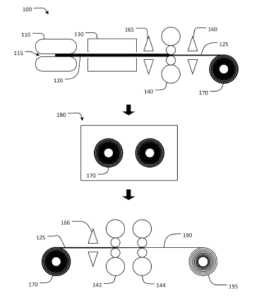
US11040352 — SYSTEM FOR MELTING ALUMINUM AND RECYCLING BLACK DROSS — DS Liquid Co., Ltd. (Korea) — The present invention relates to a system for melting aluminum and recycling black dross, including an aluminum melting furnace responsible for melting aluminum scraps in molten aluminum and a black dross recycling device responsible for recycling black dross generated when the aluminum scraps are melted in the molten aluminum. The aluminum melting furnace includes a heating chamber provided with heating units responsible for heating the molten aluminum; and a melting chamber provided with an eddy unit responsible for generating an eddy descending in a spiral in the molten aluminum, a flux supply unit responsible for adding a flux to the eddy, and a raw material supply unit responsible for adding the aluminum scraps to the eddy, wherein, in the eddy unit, black dross formed when inclusions contained in the molten aluminum are captured by the flux is repeatedly descended and floated in the molten aluminum through the eddy, so that the black dross is collected into a spherical shape to form spherical black dross, and the black dross recycling device is responsible for recycling the spherical black dross.
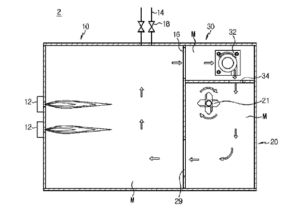
US10975461 — CASTING RECYCLED ALUMINUM SCRAP — Novelis Inc. (USA) — Techniques are disclosed for casting high-strength and highly formable metal products from recycled metal scrap, wherein the modified liquid metal includes at least 50% of recycled aluminum, then rolling the metal product. Additional alloying elements, such as magnesium, can be added to metal scrap, which can be cast and processed to produce a desirable metal coil at final gauge having desirable metallurgical and mechanical properties, such as high strength and formability. The recycled aluminum can comprise used beverage can scrap containing a mixture of recycled metal from can ends and can bodies. In some cases, the modified liquid metal comprises at least about 60% of the recycled aluminum (e.g., at least about 80% of the recycled aluminum). Optionally, the modified liquid metal can comprise a hydrogen content of 0.25 mL/100 grams or less. Optionally, the rolling comprises hot rolling the metal product to a gauge for delivery, cold rolling the metal product to a gauge for delivery, or hot rolling and cold rolling the metal product for delivery. Thus, inexpensive and recycled metal scrap can be efficiently repurposed for new applications, such as automotive applications and beverage can stock.
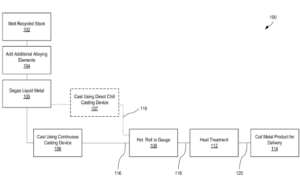
US10898928 — VISION AND ANALOG SENSING SCRAP SORTING SYSTEM AND METHOD — Huron Valley Steel Corporation (USA) — A system and a method of sorting scrap particles is provided. A moving conveyor containing scrap particles is imaged using a vision system to create a vision image corresponding to a timed location of the conveyor and is sensed using a sensing system to create a sensing matrix corresponding to the timed location. The sensing system has at least one array of analog proximity sensors. A control system analyzes the vision image as a vision matrix of cells and generates a vision vector containing vision data from the vision matrix for the particle. The control system analyzes the sensing matrix and generates a sensing data vector containing sensing data from the sensing matrix for the particle. The control system classifies the particle into one of at least two classifications of a material as a function of the vision data vector and the sensing data vector, for example, cast aluminum materials and wrought aluminum materials.
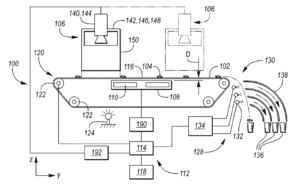
US10876188 — METHOD FOR RECYCLING SCRAP OF 2XXX OR 7XXX SERIES ALLOY — Constellium Issoire (France) — The problem that this invention attempts to solve is to propose a new method of fabricating aluminum alloy ingots in the 2xxx or 7xxx series capable of incorporating a significant fraction of finely divided scrap while obtaining a low content of unwanted impurities particularly such as alkali elements such as sodium, alkali-earth elements such as calcium and some metals such as iron. A method of manufacturing an aluminum alloy ingot using scrap aluminum alloy in the 2xxx or 7xxx series, and a fabrication method after rolling, extrusion and/or forging of an aeronautical structure comprising the steps in the above method, and then at least one rolling, extrusion and/or forging step of the aluminum alloy ingot in the series of scrap used. For the purposes of this description, a “2xxx or 7xxx Al—Li type alloy” is any 2xxx or 7xxx alloy containing a quantity of lithium exceeding 0.2% by weight and preferably 0.5% by weight. The point that these alloys have in common is the need for special precautions related to the oxidizability of lithium.
